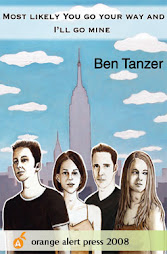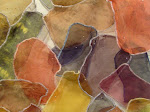 Scott David Johnson
Scott David JohnsonImagine that you live on the 40th floor of a high rise downtown Chicago, you look out your window, and see a swarm of people or a massive swat team, or emergency vehicles. However from your point of view you can't make out what actually happened. You want to look closer or find a different angle, but then the moment the has passed, the crowd disperses and you go on about your day. These are the scenes that fill the mind and the canvas of Chicagoan Scott David Johnson.
Viewing the world from that perspective makes for an interesting study of life without many of added cultural, racial, or religious aspects. In fact, in several of Scott's pieces the faces or other body parts blend or flow into one another, removing identity from tragedy or from joyous celebration, leaving a true huddled mass observing the unknown. In the statement on his website Scott puts it like this, "Up close, the unique personality of an individual can be detected. Upon retreating to observe a large group of people from a distance, individual sentiment will dissolve into the abstract patterns of a crowd. Whether these patterns suggest a street fair, a protest, or a tragic disaster, the negative space surrounding the event offers an absence of context, isolating the brush strokes in a sea of neutral color as if they were a school of fish".
Recently, Scott was able to answer a few of our questions regarding his work.

Orange Alert (OA): How would you describe your work?
Scott David Johnson (SDJ): My work could be described as "half-completed", not so much as the composition is concerned, although I do like to leave a lot of empty space. Half completed because the viewer gets a hint of what's going on in the crowd scenes, to make room for interpretation. I also sometimes like to stop working on a painting before I think it's finished. I don't like putting "finishing touches" on a painting.
OA: I enjoy the way the figures in your paintings blend together and virtually eliminate race, religion, profession, and most individual characteristic. You present a mass of people or scene in time and allow the observer to draw their own conclusions. How did you come to develop this style, and what was the original sentiment behind these paintings?
SDJ: I've been working on these crowd scenes for a few years now. This series grew out of a previous series I called the "Public" paintings. In the Public paintings I painted specific portraits of various people I had photographed without their knowledge. The figures were also surrounded by a neutral color. Eventually I got tired of painting detailed portraits straight from photographs and I wanted to create some more abstract compositions out of my head. So I widened my viewing angle to depict much larger crowd scenes. I was able to eliminate individual detail and concentrate more on the composition of a crowd as if it were an individual itself. I include a lot of things the viewer can recognize,police uniforms, ambulances, playground sets, etc. I balance this rhetoric with an ambiguity. A crash scene will be off to the side so you don't really see the gory details.A protest scene may include hundreds of S.W.A.T. police, but only a few civilians.Kids in the playground jungle gym will show no body movement, as if they were just passing through the structure as if on an assembly line. I like working this way because the line between representation and abstraction is blurred, and I'd like to take it much further.
SDJ: I've been working on these crowd scenes for a few years now. This series grew out of a previous series I called the "Public" paintings. In the Public paintings I painted specific portraits of various people I had photographed without their knowledge. The figures were also surrounded by a neutral color. Eventually I got tired of painting detailed portraits straight from photographs and I wanted to create some more abstract compositions out of my head. So I widened my viewing angle to depict much larger crowd scenes. I was able to eliminate individual detail and concentrate more on the composition of a crowd as if it were an individual itself. I include a lot of things the viewer can recognize,police uniforms, ambulances, playground sets, etc. I balance this rhetoric with an ambiguity. A crash scene will be off to the side so you don't really see the gory details.A protest scene may include hundreds of S.W.A.T. police, but only a few civilians.Kids in the playground jungle gym will show no body movement, as if they were just passing through the structure as if on an assembly line. I like working this way because the line between representation and abstraction is blurred, and I'd like to take it much further.

OA: Who are some of your biggest influences artistically?
SDJ: A lot of my favorite artists are from the past, Velazquez and Goya, Beethoven, or "Moby-Dick" for example. I enjoy the weird sensuality of recent abstractionists such as Terry Winters, Jonathan Lasker and Luc Tuymans. I love Morandi's still lifes. I see so many wild things at the art shows, and I sometimes prefer books or some music more than paintings. But I don't think of these things while I'm working. The last thing I want to do is "quote" another artist or "pay homage" to another artist, especially another painter.I don't even want Scott Johnson in the painting. I want to give anonymous reports.
OA: What is your opinion of the current Chicago art scene?
SDJ: There are a lot of fantastic artists here, Nichole Janan Chandler, for instance. There are multiple organizations an artist can get involved with for exposure of their work, and there are some grants here that are accessible.
OA: What is your typical starting point for a new piece and how long does it take to complete that piece?
SDJ: It seems that a lot of the time put into my work involves prepping the canvas and layering the backgrounds. I work on a handful of canvases at the same time so others can dry. When things are going good I'll get 2 or 3 smaller pieces done per week. It takes longer for the larger work.
OA: What is next for Scott Johnson?
SDJ: The biggest news for me right now is I have a show going on at Tinlark Gallery in L.A. In the fall I'll be participating in the Bridge Art Fair in London. Hopefully by then I'll have a lot of new work ready. I better get started.

Bonus Questions:
OA: Coffee? If yes, what is your favorite type of coffee and where is your favorite coffee spot?
SDJ: Yes to black coffee. Anywhere.
OA: What type of music do you listen to, and who are some of your favorite musicians? Do you listen to music while painting?
SDJ: I've been listening to vintage underground new wave music from the Flexi-Pop label. I'm also continuing my personal compilation of 70's AM pop. I've been perfecting it for years and it may never get done.
SDJ: I've been listening to vintage underground new wave music from the Flexi-Pop label. I'm also continuing my personal compilation of 70's AM pop. I've been perfecting it for years and it may never get done.
For more information on Scott David Johnson visit his website.
+by+Nick+Volkert).jpg)





















No comments:
Post a Comment